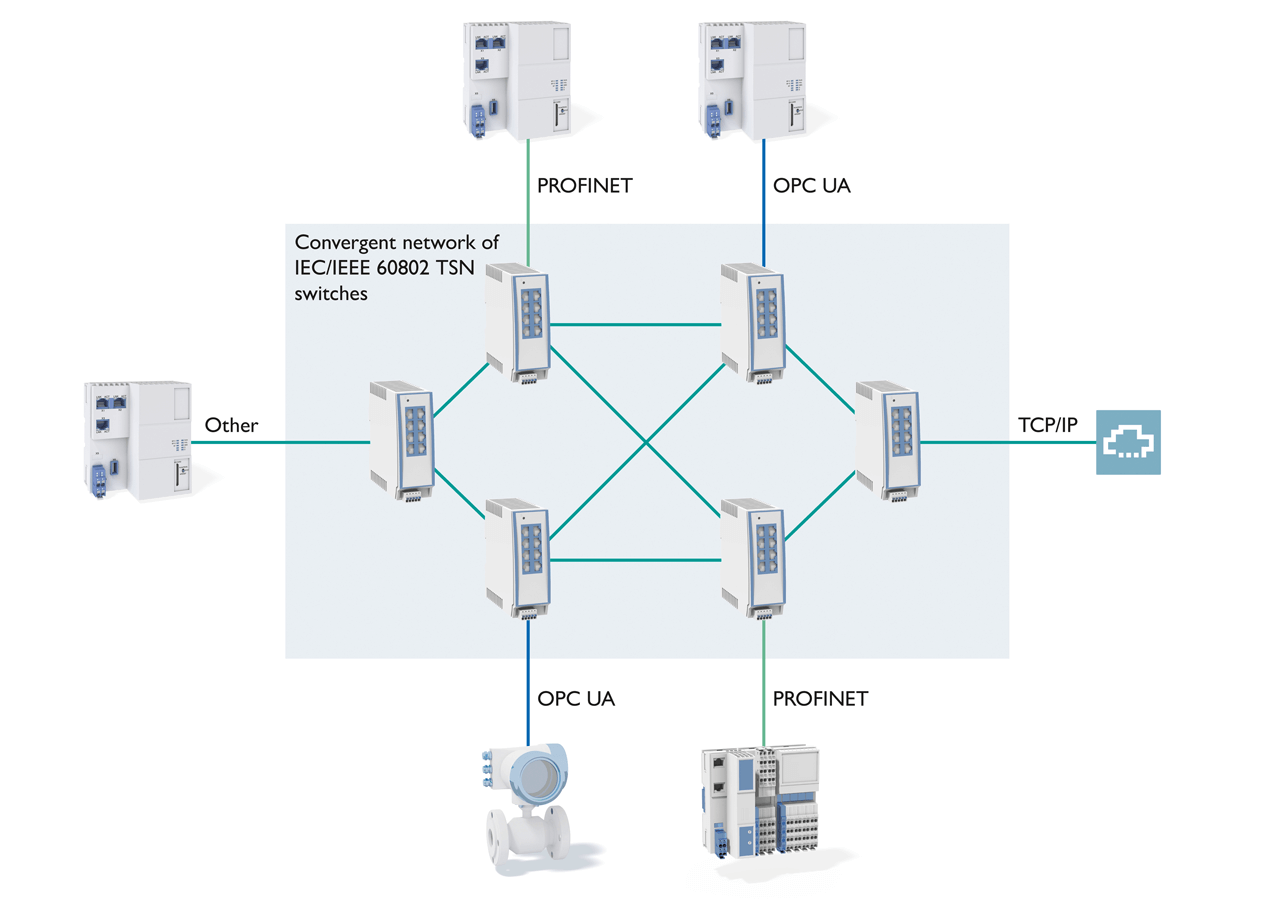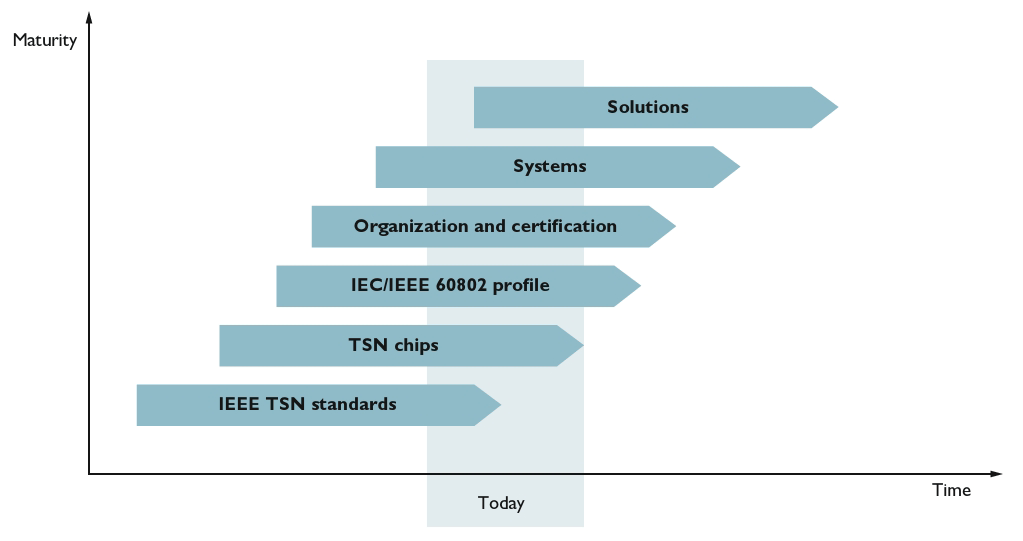TechnologyMarch 30, 2021
Path to TSN offers key to IIoT applications

Comprehensively networking everything with everything is the basis for future scenarios such as Industry 4.0 and the IIoT. To achieve this, currently separate fields of automation and information technology will have to be integrated even better. Time Sensitive Networking (TSN) standards can play a key role.
What is TSN, which standards are relevant, and how can the development work be assessed? At this point, it’s time for an overview. The classic bus systems, such as Profibus and CANopen, can still be found at the field level in current automation architectures. These systems and their use are currently proving to be a key discipline in automation technology (Operational Technology – OT).

IEEE 802 TSN standards: All standards have now been released.
Any additional TCP/IP communication necessary, for example between the field and the control level or image transmission via webcams, is currently via separate Ethernet-based networks (Information Technology – IT). Such a split means that users have to master both specialist fields, which brings with it a corresponding level of complexity and the need for further qualifications.
IT and real-time critical applications
One huge advantage of Ethernet, however, is the cross-market and cross-application standardization work of the responsible body, the IEEE (Institute of Electrical and Electronics Engineers), and in this case the IEEE 802 project. This standardization ensures the broad, cost-effective, and interoperable availability of foundational Ethernet technologies and blocks.
Systems based on Ethernet, such as Profinet RT and Modbus/TCP, benefit from these advantages because every IEEE 802-compliant end device and every switch can be used for data exchange. However, the IEE 802 work so far has not focused on the use of Ethernet in applications with hard real-time requirements, such as motion control applications. As a result, there are now special configurations available for such application scenarios, such as Profinet IRT, that are not standardized through IEEE 802, and in part only support data rates up to 100 Mbps, and that also require special device hardware.
This situation can change with TSN. With an appropriate bundle of mechanisms that are standardized through IEEE 802, Ethernet becomes real-time capable and allows bandwidths higher than 100 Mbps with simultaneous use of the network for both IT and automation applications. This means that the network can be used for all IT and real-time critical applications.
This characteristic is known as convergence and provides a series of additional advantages. For users and applications, these include bandwidths of 1 Gbps and more, transmission guarantees, seamless media redundancy, the use of standard switches, short cycle times, and, prospectively, comparable device costs.
Manufacturers benefit from the use of standard chips in controllers, switches, and field devices, and one product hardware system for all TSN use cases. It has become clear that the TSN standards apply to the lower Ethernet layers. The user layer is largely independent and can be retained as it is for existing standards such as Profinet.

Several real-time protocols and TCP/IP communication share one network.
Profiling TSN standards for OT use
One important and necessary characteristic of the current fieldbus systems is their cross-manufacturer interoperability. Automation experts have become used to combining devices from different manufacturers to create workable solutions in a machine or system. This interoperability is assured by the large fieldbus organizations via specific measures, such as certifications.
The convergent use of a TSN network can only be successful if it also provides a comparable level of interoperability. To achieve this, a cross-manufacturer definition of which mechanisms from the TSN bundle are to be used and how is necessary.
Here, IEEE 802 does not make any provisions to guarantee the cross-sector use of Ethernet. Therefore, the IEC organization responsible for the fieldbus systems has joined forces with the IEEE 802 body responsible for Ethernet to establish the joint IEC/IEEE 802 60802 activity. This cooperation is targeted at profiling TSN standards for use in automation applications. Therefore, this activity is also referred to as the Industrial Automation Profile (IAP), and makes applications.

The TSN streams in a network can be used by different protocols, necessitating cross-manufacturer and cross-protocol standardizations.
Role of the fieldbus organizations
Will the well-known fieldbus organizations, such as Profibus and Profinet International (PI), become superfluous to requirements with the introduction of TSN? At the moment, this question can be answered with a clear no.
The tasks that are currently being performed by these organizations will also have to be performed when TSN is used in order to guarantee a comparable level of operability. Moreover, the users will expect a comparable level of user-friendliness when using TSN in Ethernet networks. Therefore, Profinet has been approved for use with TSN since specification 2.4, for example. This means that users can benefit from the advantages of TSN without having to change their familiar view.
But it is not just Profinet that is specified for TSN. The OPC Foundation is also working on describing TSN standards for automation via the so-called Field Level Communication Initiative (FLC). In this context, creating another proprietary fieldbus system for TSN that does not take other systems into account is to be avoided.
Rather, the goal is the convergent use of a network, for example for OPC UA, Profinet, and other protocols. The Industrial Automation Profile (IAP) IEC/IEEE 60802 is fundamental for implementing this.
From standard to solution
The figure (right) illustrates the fundamental process of the IEEE 802 standard up to a workable solution for the user and provides a classification in terms of the current status of TSN. Because the TSN mechanisms also have an effect on the Ethernet hardware, new products or new versions of the products with corresponding Ethernet blocks are necessary. This applies in particular if the user also wants to benefit from the advantage of higher bandwidths, such as 1 Gbps.
These bandwidths are necessary in a convergent IT and OT network, for example, because video data streams demand it. At this point, it should be noted that a comparable status was achieved by the Ethernet-based fieldbus systems used today around 15 years ago, meaning that the fieldbuses have already gone through this development.
The convergence of IT and OT is also possible today with systems such as Profinet RT, and is sufficient for many applications in production and process automation, except high-end motion control applications. It can therefore be assumed that widespread use of TSN in real solutions is still some time away. The benefit of a convergent network is, however, high for both device manufacturers and users, because it is a key empowering factor for the IIoT.
Active cooperation on new communication technologies
In terms of TSN, Phoenix Contact is actively participating in all relevant standardization activities.
At the same time, TSN-capable platforms and products are already being developed. Here, the company is focusing on upgrading the existing Profinet solutions with TSN standards and, in this context, is taking the convergence of OPC UA and TSN in accordance with IEC/IEEE 60802 into consideration.
This will enable a fluid and needs-based transition from the current OT-centered view to convergent IT and OT networks with extended capabilities and characteristics.
In this context, the influences of further new technologies such as Single Pair Ethernet (SPE), 5G, and security will also be taken into account in the considerations. Phoenix Contact is thus focused on future-oriented products and solutions.


